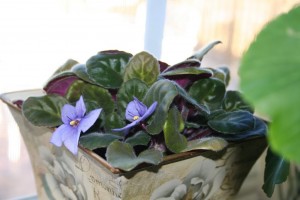
Ever write an email or a letter, then later realize you came off too strong? I guess I had a hissy a few months ago about an article in County Gardens, a magazine I look forward to each month. The winter issue had a good article about African violets in it, but the authors never mentioned chimeras. I have first hand experience with this. And I guess my annoyance and lovingly tending my violets for over a year to find them all…identical…may have oozed out from my fingertips and through my keyboard.
I’ve got 20 identical dark purple violets as living proof. I took cuttings from my sister’s plants. I know that each cutting survived. Yet even though the parents had pinwheeled and maroon colored flowers, every single blessed one is…deep purple. My favorite rock band, a great color, but I really wanted those pinwheel-flowered ones!
So today I got an email from the author of the article. I am sorry my tone upset you. I know what it’s like to have someone poke at your writing. Oh boy, after 20 years of freelancing – I sure do know it!
The long explanation about why this happens with violets is here, on the Department of Horticulture website from Ohio State University:http://aggie-horticulture.tamu.edu/tisscult/chimeras/valprop/val.html
You can make an identical plant with the pinwheel types, but you need to separate the plants at the crown, not the leaf. Others will propagate true to type from leaves.
So, dear article author and African violet expert: I sincerely apologize for my tone. I can be too strong sometimes too. Please don’t take it to heart. As a fellow writer, I should have been kinder. I just got stuck with 20 identical African violet plants, so I know this to be true…cuttings don’t always produce identical plants. (Exhibit A: yes, today’s picture is one of the nauseatingly identical plants I lovingly cultivated. I’ve got the monocolor thing down pat in my plant room.) And I’d love to have you as a guest blogger if you ever want to share your experience growing prize winning violets. I just love my violets, even if they are all dark purple!





You have passion in your writing. You care deeply about your garden, your family, your pets, your faith. That makes you an interesting person and makes your writing interesting too. And it is the passion that sometimes makes us impulsive and “sandpapery”. Bet it was the passion that made you find out why your cuttings turned out like they did.
Liz